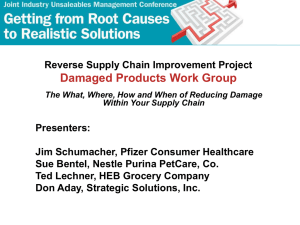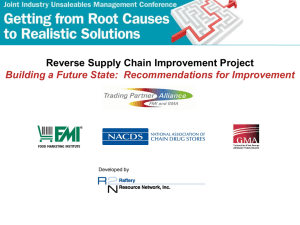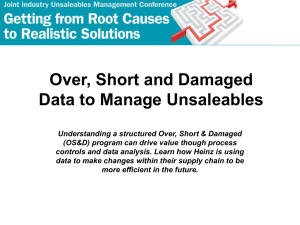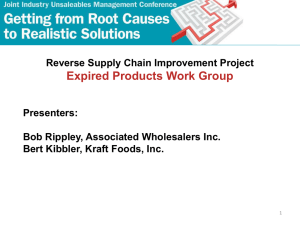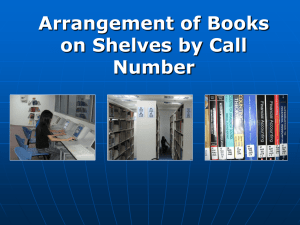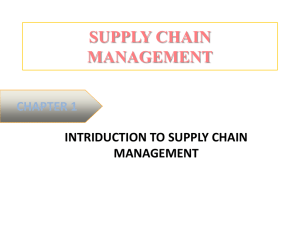Unsaleables 101 - Grocery Manufacturers Association
advertisement
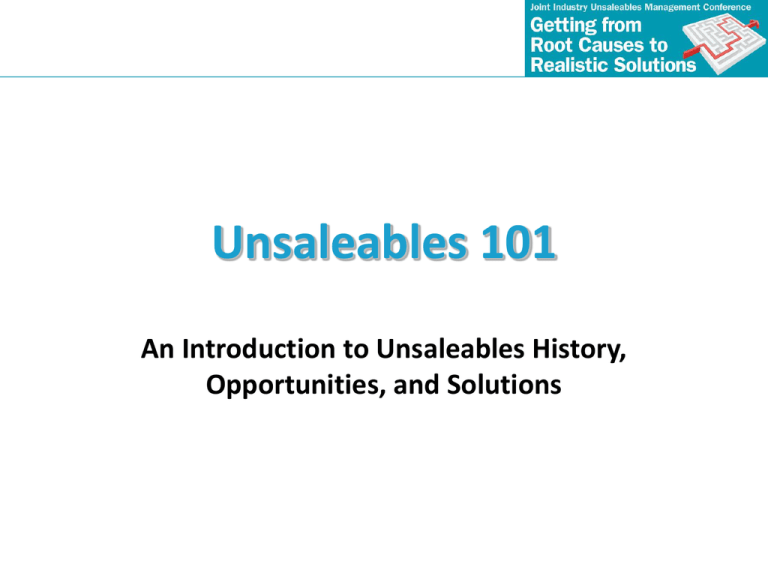
Unsaleables 101 An Introduction to Unsaleables History, Opportunities, and Solutions Agenda A History of Unsaleables Gary Spinazze Unsaleables Opportunities Ted Lechner Eugene Schachte Unsaleables Solutions Rob Shifter Legal Disclaimer • Presentations are intended for educational purposes only and do not replace independent professional judgment. • Statements of fact and opinions expressed are those of the participants individually and, unless expressly stated to the contrary, are not the opinion or position of the Grocery Manufacturers Association (GMA), its cosponsors, or its committees. • The GMA does not endorse or approve, and assumes no responsibility for, the content, accuracy or completeness of the information presented. • Material within this presentation is intended to be used for purposes of education and discussion stimulation only. Unsaleables: A History Gary Spinazze What are Unsaleables? Unsaleables is defined as: “Any product removed from the primary channel of distribution, regardless of the reason for removal. This includes, damaged, seasonal or out-of-code products.” Unsaleables Timeline JIR Published Reclamation Center Growth 1985 1990 Initial Unsaleables Benchmark Study Initial ARP Implemented JIULT Formed 1992 Updated JIR Published 1995 1997 2005 2008 Joint Industry Unsaleables Report 2008 2009 Reclamation Centers • What is a Reclamation Center? Central location for collection and processing of unsaleables product. Can be owned by distributor or 3rd Party. • What is the purpose of a Reclamation Center? To control disposition of unsaleable product As a central return point for recalls To ensure proper issuance of store credit Joint Industry Report (JIR) • Published in 1990 • This document became “the bible” for unsaleables in the Industry Joint Industry Report (JIR) • Study provided guidelines for: – – – – – Applicable products Reimbursement Disposition Reclaim process Shared responsibility – Costs • Guidelines still used today for policy development and implementation. – Referred to as JIR Policies – Reimbursement based on list cost Joint Industry Unsaleables Leadership Team • The JIULT was Formed in 1992 • Deliverables: – Benchmarking Report – The Unsaleables Conference – Projects based on the JIULT mission statement. FPA Dist. GMA JIULT FMI Mfg. FPA Dist. GMA JIULT FMI The mission of the JIULT is to: Mfg. Provide strategies, educational content and tools to help Retailers, Distributors and Manufacturers reduce the volume of unsaleable goods within the consumer package goods (CPG) value chain. This will be achieved by: • • • • Developing strategic management applications Identifying and sharing successful practices and recommendations Creating educational platforms Collecting and disseminating industry intelligence on emerging trends and developments Unsaleables Benchmark Reports • In 1995, the JIULT began producing recurring Benchmark Reports – Survey Distributors and Manufacturers – Report overall rates – Report state of industry Adjustable Rate Policy (ARP) In 1997 the first ARP was introduced in the industry WHAT IS IT? • Rate based policy • Assessments of supply chain 60% of damage & root cause Market • Requires substantial resources & investment Share is • Requires use of independent 3rd currently party • 18-24 onmonths to develop and implement ARP * * 2008 Joint Industry Unsaleables Report Joint Industry Report Update - 2005 In 2005, a “New” JIR was published FPA Dist. GMA JIULT FMI Mfg. • Support “original” JIR • Address industry changes • Raise Unsaleables to a Senior Management Issue • Importance of reclaim centers • Identify Unsaleable ARP Components – What should and shouldn’t be included • Continued Collaboration Unsaleables Benchmark Reports • The 2008 version is available on the GMA website – www.gmabrands.org What Are The Opportunities Today? Commitment Tight Economy Inventory Management ARP “GAPS” Collaboration Exit Strategies Sustainability Shelf Life SKU Rationalization Unsaleables Opportunities Ted Lechner - HEB Danielle Kowalkowski – Heinz North America Unsaleables Opportunities: Part I Policy Recalls Damage Unsaleables Open Code Dating & Expired Discontinued Seasonal & New Items Unsaleables- Damage • Packaging Issue – – – – Cardboard Strength Compression Damage Tray Pack vs. full Case Is going Green, Costing us GREEN? • Platform Issues – Poor Pallets • Use Pool Pallet, CHEP, IGPS, PECO • WW Grade A or B only – Pallet overhang or underhang • Damage Reduction is an Attitude – Damage is not an acceptable supply chain practice Unsaleables- Discontinued • Manufacturer Discontinued – Normally funded – Product disposition options • Mark down at Retail, or bill back through Reclaim • Retailer Discontinued – – – – Normally not funded by supplier Retailer specific discontinued Product Disposition Mark down at retail, Salvage sales, UnsaleablesSeasonal & New items • Seasonal – Special one time pack – One time buy items – Holiday product • Easter, Halloween, Christmas etc, – Exit plan needs to be discussed up front • New item introduction – Product failure – Included in SWELL policy – No exit strategy Is it Really the greatest thing since sliced Bread? UnsaleablesOpen Code Dating & Expired Product • Open Code Dating – What is the correct shelf life – Who determines the correct shelf life – Why is some Julian Dated and some open code dated? • Receiving Shelf life – How much shelf life should be left at time of receiving – Who determines that shelf life? Retailer, Manufacturer? • When do you pull out of date from Shelf – When it is expired or days before? – Who owns Expired Product Financials? Freshness belongs to the Consumer not the Supply Chain Unsaleables-Recalls • Recalls – Quality issues – Handling Charge dispute • Store Handling • RGC Handling • Quality Assurance handling, notification – Product disposition • Who is responsible? • Hazardous Material? • Certificate of Destruction? • Land fill charges? Unsaleables- Policy – What is the Right Policy • JIR or Swell • Benefits of Policy • JIR you see data, Swell you don’t – Exploring the GAP • Who should pay the difference? • Shared Responsibility • Trade funds? – Where should we focus our energy? • Policy dispute or Reducing Damage? –IF you focus on the right thing you will do the right thing What did you learn? • Unsaleables is complicated! • It takes Retailer and Manufacturer to make a different! • Facts not Emotions! • You can make a difference! • Focus on the right thing, and you will do the right thing! • Cost Reduction is why you are here today! • Failure is not an option Don’t Miss These Sessions Reverse Supply Chain Improvement Project Work Groups • Wednesday – 10:45 Breakout Session – Retailer/Wholesaler Discontinued – Manufacturer Discontinued • Wednesday – 2:45 Breakout Session – Recalled Products • Thursday – 10:00 General Session – Damaged Products – Expired Products Unsaleables Opportunities – Part II Gene Schachte Sr. Manager, Reverse Logistics Unsaleables Opportunities: Part II 1. Expired Product – Open Code Dating – Product Rotation 2. Recalls and Withdrawals 3. Organizational Structure What Is Open Code Dating? • ‘Best if used by’, ‘Sell by’, or ‘Expires on’ format • Freshest possible product • Primary and secondary packaging • Bill of Lading A complete guide to open code dating and the supply chain was published in 2007 and can be found at: http://www.gmaonline.org/publications/docs/2007/O penDate.pdf Open Code Dating Examples Good OK • Month – Day – Year Format • Month – Day – Year Format • Legible and easy to find • What does the date mean •Use by, sell by, expires? • Legible and easy to find • Use of Best By Open Code Dating Examples Better • Month – Day – Year Format • Legible and easy to find • Use of Best By • Correct Size OK • Month – Day – Year Format • Too Small • Hard to find • Bottom of case Open Code Dating Challenge Remaining shelf life = ongoing debate The amount of shelf life left at time of receipt at the customer warehouse Customer requirements vary Most manufacturers’ WMS systems are not capable of different ship statuses for different customers What does the consumer require for pantry Opportunity: Product Rotation • Shared Responsibility • Manufacturer – – – – Ensure FIFO of shipments Maximize turns At-shelf rotation schedules Case identifier • Retailer / Distributor – – – – At-shelf Periodic During category resets Proactive communication Opportunity: Product Rotation Shelf ready trays Shelf rotation racks Product Rotation: Challenges 1. Labor costs 2. Other Priorities – shelving, pricing, new item etc. 3. Variable Formats / Hard to Read code dates Recalls and Withdrawals Product recalls have become more frequent… and more expensive. Fines and fees have been introduced by most retailers. - Formalized and substantial Cost of recall - anywhere from 300% - 3,000% of normal reclamation volume Considerations as you begin Where is your program now? What is your end state? How is your corporate culture? Do you understand the causes? What do your customers think? Unsaleables Program Roadmap Support & Structure • Executive Support • Organizational Structure Executive support needed Resources Company focus and priority Corporate culture Performance measurement Long term program stability Customer relationships Organizational Structure Structure varies based on: Size of company Culture Core competencies Reporting Relationship Sales, Supply Chain, Finance, Cross-functional Size Varies by company Average is manager and analyst Unsaleables Program Roadmap Structure - Example • Unsaleables Manager Responsible for strategic direction Interface to customers Resource for front-line sales • Unsaleables Analyst Reporting Data Analysis Tools • Liquidation Analyst Alternate channels Supply Chain Sales Finance U n sa le ab les M a na g er U n s ale a b le s Ana lyst L iq u id a tion An a ls yt Unsaleables Program Roadmap • Executive Support Support & Structure • Organizational Structure • A versatile skill set Resources Communication: oral + written Aggressive + An Influencer Detail Oriented + Strategic Focused + Flexible Broad cross functional skills Unsaleables Program Roadmap Support & Structure Resources Opportunity • Executive support • Organizational structure • A versatile skill set • Reporting tracking and measuring Can we rank our: Customers Do are We know ourPeer Where we vs. our Factories Companies? Unsaleables Expense? Brands Warehouses Unsaleables Program Roadmap Support & Structure Resources Opportunity • Develop enablers Tools • Capability building tools Levers and Enablers: 1. 2. 3. 4. 5. 6. Internal reporting and tracking Customer reviews Internal root cause studies Customer collaboration studies Discontinued markdown programs Product rotation schedules Unsaleables Program Roadmap Support & Structure • Executive support • Organizational structure Resources • A versatile skill set Opportunity • Reporting tracking and measuring Tools Strategy • Develop enablers • Capability building tools • Customer relationships • Policies and procedures • Long term plan Unsaleables Solutions Rob Shifter Let’s work together • This applies to: – Vendor / Manufacturer – Wholesaler / Distributor – Retailer Big opportunities Building blocks for success • Data • Audits (3rd party and internal) • Damage reduction • Inventory management • Current practices • Supporting policies • Policy assessment • Collaboration Using data Unsaleables data – defined and consistent • Measured vs. sales volume & dollars Total unsaleables by SKU Total profitability by SKU over time Using data Understand the data sources • Who? Retailer/Distributor, Manufacturer, 3rd Party, Industry benchmark • True and accurate • Complete Does it represent the entire supply chain? • Representative sample size Using data Analyzing the Data • What is captured and compared? Warehouse damaged and expired Damaged, distressed, and expired at store level Short dated receipts New product launches Discontinued items • Can we identify root causes? Product handling Rotation Delivery practices Packaging issues Inventory management and position Inadequate remaining shelf life Using data Discussing Data • Be fact based Removes emotion from discussion Confirm accuracy Cornerstone for solving problems 3rd party audits Audit Planning • Have a mission statement and a goal • Frequency – One shot or ongoing • 3rd Party or Manufacturer/Distributor team • Scope Statistically significant Fulfill pre-defined parameters Document current process flows Broad product and geographic scope Should include all classes of trade Should audit complete supply chain – plant to shelf Include hidden damage assessment • Shared responsibility • Should include interviews with key players 3rd party audits Obtain Actionable Data • Product age • Expired rate • Damage by product/package type • Product unit location where damage occurred • Shipping platform • Inbound damage disposition Are we reacting at time of receipt? 3rd party audits Summarize, Analyze Data, Process Improvement • Debrief on audit and share results • Identify areas of opportunity • Revise processes (i.e. damage handling process) • Review new processes with key players • Initiate improvement plans • Measure results and continually improve • Adopt zero loss mentality Damage reduction Manufacturing/packaging improvements • Corrugate strength • Pallet configuration • Shipping container design (headroom, etc.) • Adhesives • Date code printers Distribution improvements • Stretch wrap application • Load configuration • Dunnage Inventory management Working Capital Focus • Increased focus on reducing inventory for all parties • Moving closer to Just-in-Time inventory processes • Rapid replenishment models – LTL shipment impact Additional Inventory Impact Activity • Resets - How do we minimize the impact to unsaleables? • Recalls - Proactively coordinate the removal of product from the full supply chain quickly and efficiently • Store-Level Data – How do we leverage store sell-thru data Inventory management Code Dating • We are in an open code date environment • Are we using this as an effective tool to prevent unsaleables? Product Rotation • Are we auditing and validating that product rotation is taking place? In Warehouse At shelf • Manufacturer owns within their supply chain Warehouse Management System (WMS) • Maximize turns • Periodic at shelf rotations Inventory management Product Discontinuations • Drivers for discontinuations Package/Size change Product changes SKU rationalization Category management Seasonal items Brand ownership changes Slow movement Store redesigns Inventory management Product Discontinuations • Processes and procedures are the key Execute established exit strategies Is the plan proactive? Is there a phase out approach? Customer Geography Class of Trade Liquidation Inventory management Exit Strategies and Collaboration • Can be in conjunction with entrance strategy for new items • Success is better when trading partners collaborate and communicate • Implementation improves sell through and minimizes reclaim • Effective program addresses warehouse inventory (full case) and shelf inventory • Effective program tools include: Markdowns (Separate from unsaleables program/policy) Trade funds Coupons • Primarily for discontinued products, but can also be used for underperforming products Practices Review Current practices • What is embedded in our process that causes damage? • What tools are in place to ensure they are correct and measured? • What are our policies on: • Loading and unloading • Ordering • Product rotation • New or discontinued Items • Seasonal items • Code date requirements Supporting policies OS&D Policy • Receiving process is a key step to eliminate unsaleables damaged product from entering the distributor supply chain. • Provides visibility to product damaged through the supply chain. • Enabling and executing compliance to OS&D policy. • Report data and use to drive solutions. Customer Initiated Return Policy • Address hidden damage cases in warehouses. • Minimize excess and aged inventory. • One option for disposition on discontinued/seasonal items. Policy assessment Unsaleables Policy Assessment Tool • Measures offered vendor policies using a consistent and methodical process. • Acts as a catalyst for review of internal policies to identify opportunities in your organization. • Available at: http://www.gmaonline.org/downloads/research-and-reports/AssessmentTool.xls Collaboration Activities that require collaboration • • • • • New item introductions Discontinued items Seasonal items Resets / Plan-o-gram changes Recall management • Promotion planning Collaboration Working together • Benefits are achieved by both trading partners through: Collaboration Data sharing Shared focus on unsaleables • Steps to Effective Collaboration Open lines of communication Develop “trust” Share data Identify issues (internal and external) / Develop a plan Agree on goals Commit to improvement Take action – Work together for “Win-Win” solutions Measure and analyze results Collaboration Effective collaboration in action • The key is understanding of mutual supply chains • Create a cross functional team Manufacturer: Sales Finance Logistics Packaging Warehousing Customer Service Unsaleables Management Supply Chain Leaders Marketing Distributor/Retailer/Wholesaler Reclamation Category Management Finance Supply Chain Logistics Warehousing Inventory Control Moving forward As We Move Forward, We Should Remember: 1. 2. 3. 4. 5. It’s OK to disagree, but don’t let that stop the process. Avoid data paralysis. Use the data to move toward collaboration. Go after low-hanging fruit first, then stretch. Work with a goal of improving trends. Questions
